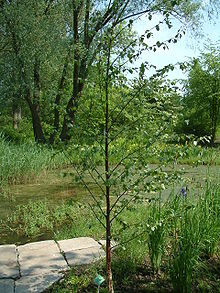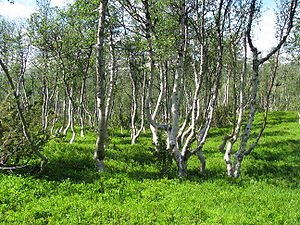- Betula pubescens
-
Betula pubescens 
Scientific classification Kingdom: Plantae (unranked): Angiosperms (unranked): Eudicots (unranked): Rosids Order: Fagales Family: Betulaceae Genus: Betula Subgenus: Betula Species: B. pubescens Binomial name Betula pubescens
Ehrh.Synonyms Betula alba
Betula pubescens (syn. Betula alba; Downy Birch; also known as White Birch, European White Birch or Hairy Birch) is a species of birch, native and abundant throughout northern Europe, Iceland, northern Asia and also Greenland.[1]
Contents
Characteristics
It is a deciduous tree growing to 10–20 m tall (rarely to 27 m), with a slender crown and a trunk up to 70 cm (exceptionally 1 m) diameter, with smooth but dull grey-white bark finely marked with dark horizontal lenticels. The shoots are grey-brown and finely downy. The leaves are ovate-acute, 2–5 cm long and 1.5-4.5 cm broad, with a finely serrated margin. The flowers are wind pollinated catkins, produced in early spring before the leaves. The fruit is a pendulous cylindrical aggregate 1–4 cm long and 5–7 mm diameter, which disintegrates at maturity releasing the individual seeds; these are 2 mm long with two small wings along the side.
Species identification
It is closely related to, and often confused with, the Silver Birch (B. pendula). Many North American texts treat the two species as conspecific (and cause confusion by combining the Downy Birch's alternative vernacular name 'White Birch', with the scientific name B. pendula of the other species), but they are regarded as distinct species throughout Europe.
Downy Birch can be distinguished from Silver Birch in having smooth, downy shoots, which are hairless and warty in Silver Birch. The bark of the Downy Birch is a dull greyish white, whereas the Silver Birch has striking white papery bark with black fissures. The leaf margins also differ, finely serrated in Downy Birch, coarsely double-toothed in Silver Birch. They are also distinguished cytologically, Silver Birch being diploid (with two sets of chromosomes), whereas Downy Birch is tetraploid (four sets of chromosomes). The two have differences in habitat requirements, with Downy Birch more common on wet, poorly drained sites such as clays and peat bogs, and Silver Birch found mainly on dry, sandy soils.
Distribution
Downy Birch extends farther north into the Arctic than any other broadleaf tree. Specimens of the subarctic populations are usually small and very contorted, and are often distinguished as Arctic Downy Birch, Betula pubescens subsp. tortuosa. This subspecies is notable as being the only tree native to Iceland and to Greenland, where large specimens can reach 13 m.
 A subspecies of Downy birch forms the treeline in most of Scandinavia.
A subspecies of Downy birch forms the treeline in most of Scandinavia.
Cultivars
- 'Pendula' - with a leader and weeping branches.[2]
- 'Pendula Nana' - umbrella shaped without a leader and with weeping branches.[2]
Uses
In Sweden, the bark of birch trees was ground up and used to make a form of bread. The removal of bark was at one time so widespread that Carl Linnaeus expressed his concern for the survival of the woodlands.[3]
References
- ^ Den virtuella floran: Betula pubescens distribution
- ^ a b Govaerts, R., Michielsen, K. & Jablonski, E. (2011). Untraced Weeping Broadleaf cultivars: an overview. Belgische Dendrologie Belge 2009: 19–30.
- ^ Lindahl, Julie (January 9, 2011). "Bark Bread is back". Nordic Wellbeing. http://www.nordicwellbeing.com/Julies_Kitchen/2011/01/09/bark-bread-is-back/. Retrieved July 21, 2011.
Categories:- Betula
- Flora of Subarctic Europe
- Flora of Greenland
- Flora of Iceland
- Flora of Finland
- Flora of Russia
- Flora of Siberia
- Flora of Armenia
- Plants described in 1791
- Trees of continental subarctic climate
- Trees of subpolar oceanic climate
- Garden plants of Europe
- Ornamental trees
Wikimedia Foundation. 2010.
